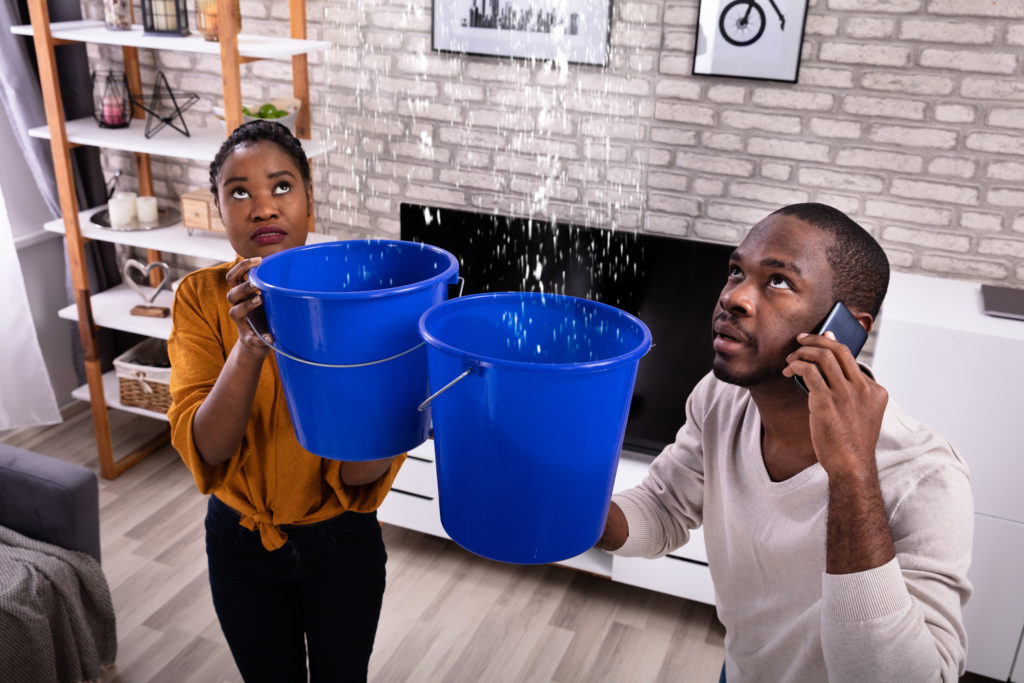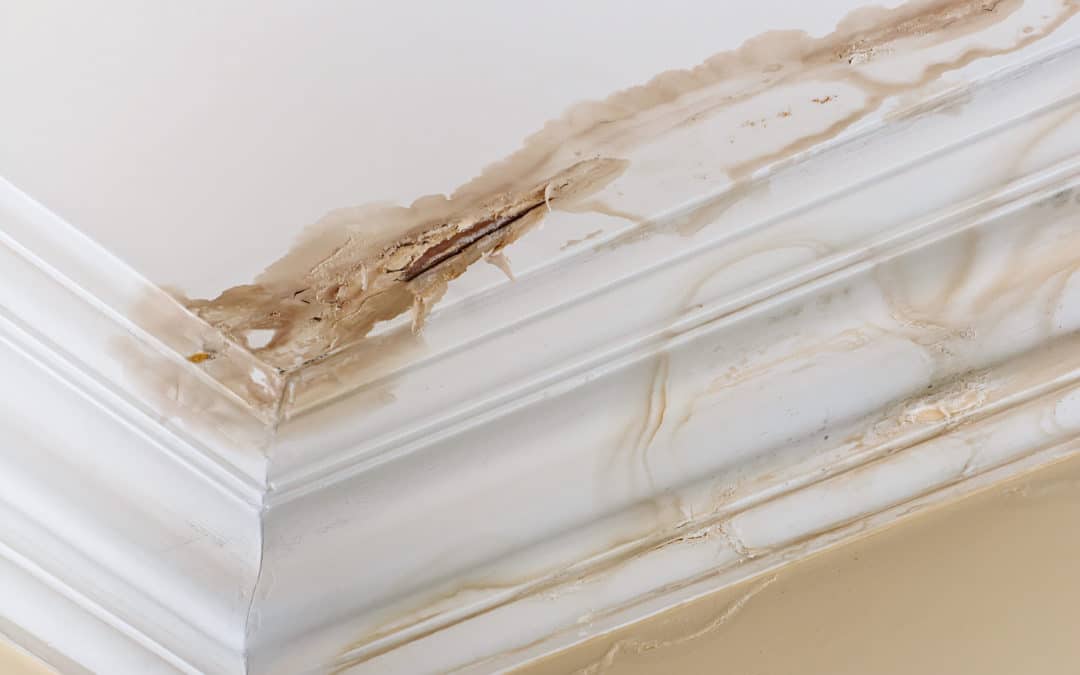Constant vigilance and routine maintenance can detect the signs of leaks in your home. Leaks are sometimes hard to notice and they rarely make enough noise to attract your attention. Whether buying, selling, or maintaining a home, signs of water damage pose one of the most significant issues facing homeowners.
Knowing how to check for water damage may help preserve your home’s structure from decay and ruin. At Restore Remodel Renew, we can return your home to its previous beauty before water damaged it!
Sign #1: Water in Your Living Space
While you may not notice a leak for a long time, you can easily identify the home water damage it creates. The walls, ceiling, and floor show watermarks or the effects of exposure to water. Taking a close look at clearly visible in your home’s physical condition helps you know how to check for water damage.
Water Rings
A circle with a border of a different color than a ceiling or wall means that a leak created it. One of the easiest indoor watermarks to find, leaks on wallboard leave an indelible impression.
Cracks in Flooring
Your carpeting may need a closer look than wood, laminate, or tile flooring to detect signs of water damage. A frequent check in the areas you do not often use can help prevent mold growth. Warping or cracking of rigid floor coverings almost certainly means water underneath.
Puddles on the Floor
In areas where you use water, you may expect some to spill on the floor. However, a puddle near the shower stalls, dishwasher, or washer in the laundry room may mean trouble. Standing water may take a while for you to notice, but it can contribute to the long-term degradation of your home. Not suitable for a do-it-yourself project, a water-damaged home requires repair by a professional artisan.
Musty Smell Under the Sink
The piping under your kitchen sink provides hot and cold water for cooking and washing dishes (by hand or automatically). Any one of them can spring a leak, and the closed cabinetry prevents you from seeing them. Obscurity provides a thriving environment for mold to form and grow.
Rust on Metal
Hot water heaters usually remain well out of sight by design because no one wants to look at them. However, a periodic check for rust can alert you to a leak. Water heaters can flood an area with 30-40 gallon tanks that serve two or three people. Families of five or more may require a 60-80 gallon unit.
Sign #2: Accumulating Water Below Ground Level
Some leaks may occur in the basement when your hot water heater or washing machine occupies available space. Also, a sudden failure in pipe wall integrity or connections can produce emergency conditions that require immediate attention. However, a more far-reaching cause of basement flooding presents serious issues that many homeowners face.
Missing Gutters
While some homeowners consider gutters an optional feature for aesthetic purposes, they provide much more than that. Rain that runs off a roof requires direction to prevent it from pooling around a home’s foundation. A guttering system with downspouts controls the flow of water and prevents potential leaks into a basement.
Ground Saturation
Storage space never seems quite enough in many homes, and the basement often seems an excellent place to store unneeded items. Whether finished or not, the basement can receive extensive damage to drywall and flooring. Construction materials such as wallboard can never return to their original shape after getting wet. Inflexible flooring can loosen, warp, and crack in damp conditions.
Examining Basement Walls for Dampness
When heavy storms occur, water may seep through the porous concrete that forms the basement in many homes. Water damage that remains unnoticed can create conditions that allow mold to grow. A musty odor can alert you to the need for professional repair. Water damage in houses creates a potential for structural defects and respiratory issues.
Sign #3: Water Intrusion from the Attic

Warm temperatures in Florida can bring rainstorms that may allow leaking into an attic, and winter has its own particular influence on leaks. At Restore Remodel Renew, our dry-out and water remediation services can work miracles on possessions you thought lost.
Ice Jams
Some of the coldest Tennessee winters can create conditions in your attic that allow moisture to accumulate. The cycle starts with snow on the roof that melts and runs into colder eaves until it refreezes. The melting process allows pools to form and build ice jams that allow water to seep into the attic.
Inadequate Ventilation
Multiple vents for ceiling-installed appliances can allow the heat in your home to escape into the attic. To counteract its impact, a free flow of cold air from outside can prevent moisture buildup.
Worn-Out Flashing Sealant
The metal sealing around your roof vents, skylight, and chimney can wear with age and allow water to seep into the attic.
Drooping Ceilings
A pool of water on the floor of your attic means the drywall in your ceiling may collapse from the weight. Not resistant to water, drywall absorbs it and expands. While it may seem an extreme measure to take, you can relieve the pressure by opening a drain hole to let the water fall into buckets below. It may create a mess, but it will be far better than allowing a ceiling to collapse!
Sign #4: Foundation Problems
The selection of a home site can affect its ability to resist leaks for its entire life span. Things that you think may never cause or lead to a leak can surprise you. A home that sits on the highest point in a property may avoid drainage problems. However, a grade that slopes gently away from a house allows water to flow to low areas in a yard. Without it, water collects around the foundation and creates damp conditions that affect its integrity. Pooling around a home’s perimeter concentrates water where it can do the most harm.
Jammed Doors
As a foundation responds to saturated ground, it can shift and change the tolerances that carpenters allow in the door openings.
Cracks in Walls, Floors, and Doors
A well-built home that experiences saturated ground around its foundation can develop unsightly cracks. They do much more than mar the appearance by revealing potential structural defects.
Sticking Windows
Humidity can make double-hung windows difficult to move up and down, but a change in the weather can fix them. Not so with windows that stick because of a shift in a home’s foundation.
Leaning Chimney or Sinking Porch
Best seen from an outdoor location, a porch that seems lower than usual sends a signal that the foundation has stability issues. Equally or even more alarming, a tilting chimney indicates severely altered soils around the foundation.
Bowing Basement Walls
While the structure of a home provides a secure living space, the foundation can cause unanticipated challenges. The constant pressure of water-soaked soil can cause the basement walls to bow and produce dire outcomes.
Sign #5: Aged or Damaged Roof
Maybe the most important part of your home’s envelope, the roof faces the elements that cause wear every day. When you want to know where to start looking for the cause of home water damage, the roof offers the most likely source of problems.
Worn Shingles
The asphalt shingles that most homes choose for roofing contain oil that allows expansion and contraction. However, flexibility wears out over time, and shingles crack and curl. The granules that make them shed water end up in the gutter or on the ground as leaks start to occur with frequency.
Leaf-clogged Gutters
A mass of debris in gutters can impede the flow of water and cause a backup that seeps into the edges of the roof. As the wet sheathing decays, the shingles have no support that keeps them attached to the roof. A strong wind can tear them away and leave the roof exposed to the elements.
Breaches in Roof Integrity
Any object that interrupts the protective covering of a roof can let water get under the shingles. While some provide architectural features such as skylights that enhance living spaces, others allow essential functions. Toilets and drains need the air vents that appear on almost every home to function correctly. Chimneys enhance a living space with the artistry of a fireplace, but they interrupt the integrity of a roof system. Therefore, the sealant that bonds flashing to the shingles can dry out and become brittle over time. As a likely cause of water damage in houses, defective sealant provides one of the best places to check first.
Restore, Remodel, Renew: A Trusted Remediation Service
When water enters your home and creates damage to your treasured possessions, it produces frustration and sadness. We help you recover from the loss that it imposes with our range of services!
Whether you need mold damage repair or to dry out from storm, fire, or water damage, we can help put things right again. Contact Restore Remodel Renew to see how our expert emergency restoration service can give you peace of mind. If you’ve noticed signs of water damage in your home, let us help you out!


Recent Comments